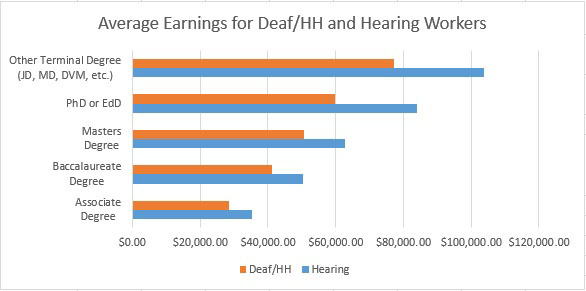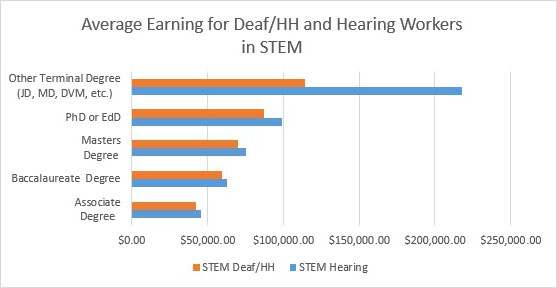Why is a path to STEM a good choice for deaf and hard-of-hearing students?
It is well known that STEM-related careers will outpace non-STEM careers well into the future, and that there are more STEM jobs than there are qualified candidates to fill them.1 For deaf and hard-of-hearing students, training for a STEM career is a particularly smart career since, on average, deaf and hard-of-hearing workers in STEM careers earn 30% more than deaf workers in non-STEM careers, regardless of degree:2
Average earnings of deaf/hard-of-hearing workers in STEM and non-STEM careers, by degree awarded, ages 16-64
| STEM | Non-STEM | Percentage | |
|---|---|---|---|
| Associate Degree | $42,322 | $31,520 | 26% |
| Baccalaureate Degree | $59,409 | $44,332 | 25% |
| Masters Degree | $70,169 | $52,808 | 25% |
| Ph.D. or Ed.D | $87,155 | $56,511 | 35% |
| Other Terminal Degree | $114,394 | $71,675 | 37% |
| Average Earning Advantage | 30% |
Average earnings of deaf/hard-of-hearing workers compared to hearing workers ages 16-64
There also exists a significant wage gap between hearing and deaf/hard-of-hearing workers, regardless of college degree. On average, deaf and hard-of-hearing workers earn only 75% of what hearing workers earn.

However, for workers in STEM fields, except in the case of the highest terminal degree, the wage gap between hearing and deaf/hard-of-hearing workers shrinks. In STEM fields, deaf and hard-of-hearing workers make 90% of hearing workers’ earnings instead of 75%.

Moving deaf and hard-of-hearing students toward STEM
In the US, deaf and hard-of-hearing people attend college at almost the same rate as hearing people, but graduate at a much lower rate: 60% of deaf/hard-of-hearing people attend some college compared to 68% of hearing people, but only 24% of deaf/hard-of-hearing students graduate compared to a graduation rate of 40% for hearing students. DeafTEC provides resources for students, teachers, parents and counselors for improving those rates of graduation. But it isn’t enough to just improve graduation rates in general; graduating more students in STEM will improve deaf and hard-of-hearing individuals earning potential, and shrink the earning gap with hearing workers.
- National Science Board, National Science Foundation (2010, May 5). Preparing the Next Generation of STEM Innovators: Identifying and Developing Our Nation’s Human Capital. Retrieved from: https://www.nsf.gov/nsb/publications/2010/nsb1033.pdf.
- All data on deaf/hard-of-hearing and hearing earnings and on college attendance and graudation is from: Walter, Gerard G. 2010. Deaf and Hard-of-Hearing Students in Transition: Demographics with an Emphasis on STEM Education, Gerard G. Walter, June 1, 2010.


